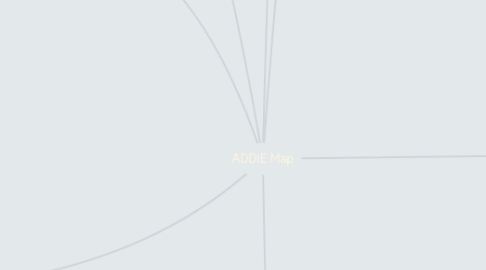
1. Defining types of Evaluations that exist through the entire ADDIE process:
1.1. Formative
1.1.1. Used in the entire ADDIE phases. Presented in reviewing the goals and objectives. Product testing and being flexible in changing how the course is effective is really important for the ADDIE process to be successful.
1.2. Summative
1.2.1. Basically a end of course assessment where learners can provide feedback in form a essay, rating system, survey, or a data gathered from the site (LMS) usage and outcome results.
1.2.1.1. Questions for my future self: what are good questions for a Summative survey?
2. E
2.1. the EVALUATE phase
2.1.1. Measure the effectiveness of the learning
2.1.1.1. Where the objectives achieved?
2.1.1.2. i.e. Grades
2.1.1.3. i.e. Project based learning means completed projected
2.1.1.4. i.e. Quiz, test, exam
3. I
3.1. the IMPLEMENT phase
3.2. Step 1: Facilitators are trained on managing the course, how to use the technology (hardware or software), teaching the curriculum, and expected outcomes
3.3. Step 2: Define to students what hardware will be needed (computer, ipads, phones) and train how to use software
3.4. Step 3: The course/training is officially released to students to start learning
4. Answer the who, what, where, when, why, and how of course development. I think you need to review/evaluate that in each step. As a self-check to stay on course.
5. A
5.1. the ANALYSIS phase
5.2. The ID identifies the instructional needs
5.2.1. What is the problem that needs solved?
5.2.2. What are the requirements?
5.3. Create or review the goals, objectives, and task for the learner
5.3.1. Define the end result and how it should be measured
5.3.1.1. Common terms : Job Performance Review, Grading System, Project-Based
5.4. Perform a pre-assessment test
5.4.1. Determine the learners previous knowledge and skills
5.5. Determine Delivery options
5.6. Determine learning format options
5.7. Set timelines
5.8. Discuss possible learning theories methods
5.9. Cost estimates
6. D
6.1. the DESIGN phase
6.2. Designs course/training with information gathered in the analysis stage, creates the visual and technical material of the course/training
6.2.1. Define Delivery
6.2.2. Define Learning Format
6.2.3. Define what learning theories to apply to course
6.2.4. Determine sequence
6.2.5. Define timing...
6.2.5.1. for students
6.2.5.2. for teacher
6.2.5.3. for course
6.2.6. Organize content
6.2.6.1. Storyboarding
6.3. Define cost
6.4. Assign role: Who will teach course?
6.4.1. What are the requirements?
6.4.2. Outsized source = $
6.4.3. Instructional Designer
6.4.4. Manager/supervisor
6.4.5. Employee
6.5. Create visual and content assets
6.5.1. Graphic Design
6.5.1.1. i.e. Infographic
6.5.2. Video
6.5.3. Voice
6.6. Create Protype
6.6.1. Review with developers
6.6.2. Review with faciliators
6.6.3. Review with others:
6.6.3.1. Student
6.6.3.2. Staff
6.6.3.3. HR
6.6.3.4. Managers
6.6.3.5. Who ever made or approves project request
7. D
7.1. the DEVELOP phase
7.2. Developers/programmers assemble content into a integrated system, in relation to technology
7.2.1. I.e. LMS=Learning Management System
7.3. Similar to back-end programming
7.4. Fully developed course/training with appropriate amount of TESTING
7.4.1. Testing functionality of course
7.4.2. Testing user-experience
7.4.3. Testing value of course
